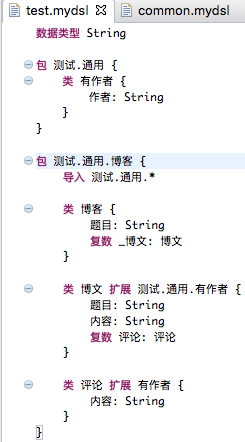環境搭建 使用的Eclipse版本: Oxygen.1a Release (4.7.1a) Build id: 20171005 1200, 通過添加 "Xtext Download" 上列出的Releases update site安裝xtext IDE和xtext SDK. 之後打開Eclips ...
環境搭建
使用的Eclipse版本: Oxygen.1a Release (4.7.1a) Build id: 20171005-1200, 通過添加Xtext - Download上列出的Releases update site安裝xtext IDE和xtext SDK. 之後打開Eclipse, 打開任何文件就報錯:
An error has occurred. See error log for more details.
loader constraint violation: loader (instance of org/eclipse/osgi/internal/loader/EquinoxClassLoader) previously initiated loading for a different type with name "org/aspectj/runtime/internal/AroundClosure"為避免現有插件和它的衝突, 新安裝了更新版Eclipse: Version: Oxygen.2 Release (4.7.2) Build id: 20171218-0600
官方教程原代碼試用
首先, 參考官方教程: 15 Minutes Tutorial
教程按部就班, 基本沒有問題. 唯一碰到的坑是最後將一個dsl文件拆分成多個時, 發現需要將項目轉換為xtext project才能支持(Xtext cross-reference across all files in project)
接著的第二個教程: 15 Minutes Tutorial - Extended, 問題多了些.
"Unit Testing the Language"部分中的文件在.tests項目的src/中, 只有個小坑. 下麵的parser就是原來模板文件中的parseHelper
val model = parser.parse(
"entity MyEntity {
parent: MyEntity
}")"Creating Custom Validation Rules"部分中的checkFeatureNameIsUnique 初一運行後, 在同一Entity內兩個同名Feature沒有報錯, ==改為.equals()也無用. 細一看之後, 才發覺它是檢查父子Entity內是否有同名Feature. 比如在Comment中添加'author'的Feature, 如期報錯.
這裡感覺到xtend語言的特別, 發現它本身也是個JVM語言: Xtend - Modernized Java, 不過貌似遠沒有Kotlin的流行度(後發現本站的代碼塊語言選項中竟然有xtend).
框架對中文的支持
首先, 嘗試生成中文關鍵詞的DSL. 預設ID只包含英文,數字,下劃線, 因此自定義IDENTIFIER,
grammar org.example.domainmodel.Domainmodel with org.eclipse.xtext.common.Terminals
generate domainmodel "http://www.example.org/domainmodel/Domainmodel"
import "http://www.eclipse.org/emf/2002/Ecore" as ecore
Domainmodel:
(elements+=AbstractElement)*;
PackageDeclaration:
'包' name=QualifiedName '{'
(elements+=AbstractElement)*
'}';
AbstractElement:
PackageDeclaration | Type | Import;
QualifiedName:
IDENTIFIER ('.' IDENTIFIER)*;
Import:
'導入' importedNamespace=QualifiedNameWithWildcard;
QualifiedNameWithWildcard:
QualifiedName '.*'?;
Type:
DataType | Entity;
DataType:
'數據類型' name=IDENTIFIER;
Entity:
'類' name=IDENTIFIER ('擴展' superType=[Entity|QualifiedName])? '{'
(features+=Feature)*
'}';
Feature:
(many?='複數')? name=IDENTIFIER ':' type=[Type|QualifiedName];
terminal IDENTIFIER: '^'?('\u4E00'..'\u9FA5'|'\uF900'..'\uFA2D'|'a'..'z'|'A'..'Z'|'_') ('a'..'z'|'A'..'Z'|'_'|'0'..'9'|'\u4E00'..'\u9FA5'|'\uF900'..'\uFA2D')*;一個小問題. 由於IDENTIFIER開頭支持下劃線, Generate Xtext Artifacts時會警告如下, 但似乎不影響語言生成, 下劃線開頭支持也正確:
error(208): ../org.example.mydsl/src-gen/org/example/domainmodel/parser/antlr/internal/InternalDomainmodel.g:571:1: The following token definitions can never be matched because prior tokens match the same input: RULE_ID
error(208): ../org.example.mydsl.ide/src-gen/org/example/domainmodel/ide/contentassist/antlr/internal/InternalDomainmodel.g:1258:1: The following token definitions can never be matched because prior tokens match the same input: RULE_ID另一個問題是, 語法規則中的規則名稱不能用中文命名(比如Feature改為'性狀', PackageDeclaration改為'包聲明'等), 否則在Generate Xtext Artifacts生成報錯並中斷:
java.lang.RuntimeException: Problems running workflow org.xtext.example.mydsl.GenerateMyDsl: Problem parsing 'file:/Users/xuanwu/work/workspace-xtext/org.example.mydsl/../org.example.mydsl/src/org/xtext/example/mydsl/MyDsl.xtext':
XtextSyntaxDiagnostic: null:10 extraneous input '包' expecting ':'經測試, DSL語言高亮在Eclipse中顯示正確:

並且生成Java Beans正確(需要將數據類型名稱由上面的"字元串"改為"String"):

另外, 經測試xtend也支持中文命名(節選DomainmodelValidator如下), 但由於xtext語法文件不支持中文標識符, 影響有限:
@Check
def void 檢驗子類無父類重名性狀(Feature f) {
var 父類 = (f.eContainer as Entity).superType
while (父類 !== null) {
for (其他 : 父類.features) {
if (f.name == 其他.name) {
error("子類性狀不能與父類中性狀重名",
DomainmodelPackage.Literals.FEATURE__NAME)
return
}
}
父類 = 父類.getSuperType();
}
}演示如下:

以上xtext項目源碼在program-in-chinese/xtext_tutorial_15_min_zh
測試DSL項目源碼: program-in-chinese/xtext_tutorial_15_min_zh
初步小結
長處:
- 工具本身和基本文檔質量尚可, 基本功能(源碼分析, 新代碼生成), 上手還算快. 應該至少可以適用於簡單DSL實驗.
- 語法規則描述接近EBNF. 好像功能更多(equivalent BNF-grammar of grammar written in XText)
短處:
- 最大問題是語法規則中標識符不能中文命名, 直接導致相關的代碼生成器(generator)和驗證器使用的多數API只能是英文(如上面的.name, .features).
- Eclipse版本或者插件衝突問題需要規避
- 需要學習xtend語言, 雖然可能很像Java
未嘗試: 可否定製自動補全功能, 語法報錯信息(比如下麵)

另外希望有機會繼續嘗試下一篇教程: Five simple steps to your JVM language



